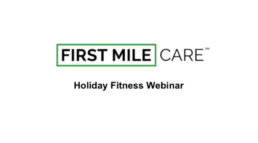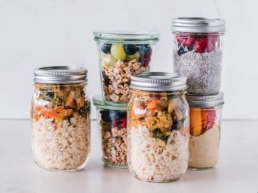By Shavon LeBlanc, First Mile Care, DPP Coach
The holidays are usually a time of parties, family outings, and travel. They will look a bit different this year but may still include indulging in rich foods that are significant to your cultural traditions. Shared family time is filled with watching sports or movies on TV, playing video and board games, and lots of fun chatter — often without organized group exercise. With the hustle and bustle of the holidays, it’s easy to let your fitness goals slide.
For many people, the holidays can be stressful. Physical fitness is a source of stress relief and can be essential in maintaining your fitness goals and reducing sedentary activity. Whether your goals are to increase your daily steps, add weights to your workout, change your eating habits, adopt a healthy mindset, or improve your overall health – pressing towards your goals is still do-able at the end of the year despite the holiday distractions.
As a certified fitness instructor, personal trainer, registered pharmacist, and coach in the National Diabetes Prevention Program (DPP), I educate people on how to lower the risk of chronic illness by making incremental lifestyle changes involving physical activity and healthful eating. I recently led a demonstration on “Staying on Track with Fitness During the Holidays” as part of the First Mile Care ongoing series of “Diabetes Prevention in Action” webinars.
The whys and hows of exercise
Exercise improves the overall quality of our lives and is truly the gift that keeps on giving. People benefit from it in different ways and degrees, but here are several of the top benefits:
- Reduced risk of chronic illness. Exercise is a key component in helping your body control its blood sugar level and insulin sensitivity which can lead to a chronic illness like diabetes. (Recent research shows that people with chronic illnesses are at greater risk of severe complications and/or death from COVID-19.)
- Weight control. Exercise helps with controlling weight. You want to try balancing your physical activity with your calorie intake. Nutrition facts labels can be a helpful guide in determining daily calorie intake.
- Mental health improvement. Exercise releases chemicals in the brain that lead to feelings of happiness and a sense of euphoria.
- Stronger bones and muscles. Exercise strengthens muscles and improves bone density. This helps reduce the risk of hip fractures and knee replacement associated with the increased risk of falls that occur as you age.
- Improved longevity and mental acuity. Exercise keeps your brain sharp and can help improve your ability to recall details as you age.
Consistency is key in reaching any goals, especially in reference to fitness. If you go 5-7 days without physical exercise, your body can lose some of the insulin sensitivity and other physical benefits you gain through exercise. It’s easy to let your fitness plan lapse over the holidays, thinking you’ll start up again in the new year, but you really want to keep up a steady rhythm and maintain your level of fitness.
When deciding on your exercise activities, keep in mind your FITT — Frequency, Intensity, Time and Type.
- Frequency is how often you exercise. First Mile Care encourages 150 minutes of physical activity a week at a minimum but ideally 30 minutes a day.
- Intensity is how much you’re exerting yourself during the exercise.
- Time is how long you exercise, which can be in small bursts. If your goal is 30 minutes a day, you can do 3 bouts of 10 minutes or even 6 spurts of 5 minutes.
- Type of exercise allows for a different level of intensity and length of time. How long you can maintain the intensity depends on your personal ability for that activity type — cardiovascular exercise, resistance training, stretching, yoga, etc.
Keeping fitness fun over the holidays
You want fitness to be fun anytime, as you’re more likely to do it. But especially during the holiday season, you don’t want it to be grueling or to feel that it’s a burden. So figure out what it is that you like to do to get your heart rate going! Your fitness goal over the holidays should be to spend less time sitting down and more time moving.
- Find a movement you enjoy. It could be bowling, gardening, volleyball, basketball, walking, swimming, dancing, using home weights – whatever gets you off the couch and moving.
- Make it fun. You’ll be more inclined to exercise if you can share it with someone, and if you vary the activity. For example, if you like looking at Christmas lights with your family, park your car and walk around the neighborhood instead of driving — and visit multiple neighborhoods.
- Make movement a priority multiple times a day. If you’re spending a lot of time in the kitchen, you can march in place or even step-tap while you’re cooking. Do simple exercises while watching a TV show. When you go to the market, park your car farther from the entrance or walk around the store one time prior to choosing your groceries, just to get in a few extra steps. Even if you’re on COVID-18 lockdown, you can stay active by moving from room to room, and if you have access to a backyard or balcony, walking up and down while getting fresh air.
- Be patient and don’t give up. There can be many challenges to deter you from reaching your activity goal. Whether it’s a wait list to use the lap pool, or inclement weather keeping you indoors, find a substitute activity to do until your preferred one is possible again.
It’s easy to feel during this busy time of year that you don’t have time for dedicated exercise. Make it easier by fitting it in as part of other activities. Remember that lifestyle change is sustainable when you are consistent in doing small things over time, and if you engage and drive other people to participate with you.
To learn more about how you can benefit from the First Mile Care Diabetes Prevention Program, take the prediabetes risk test and get started today!




